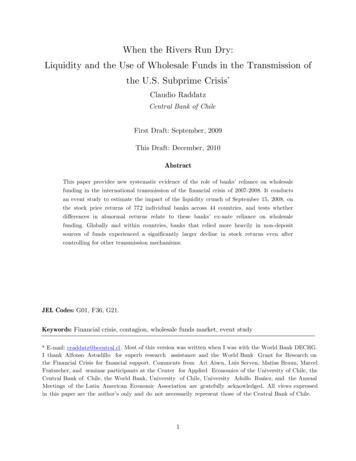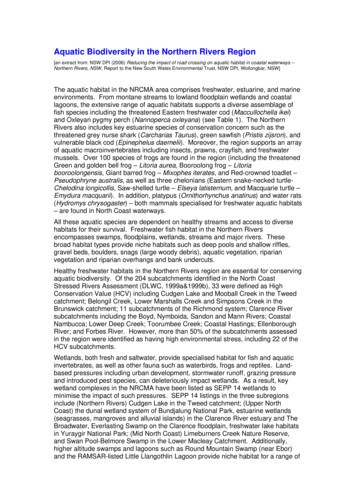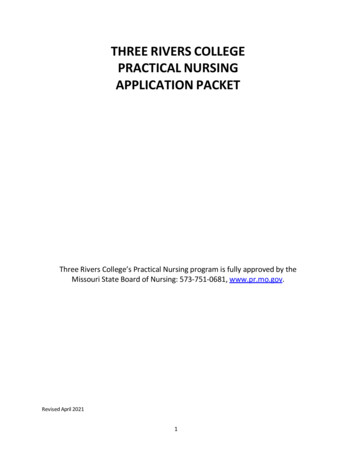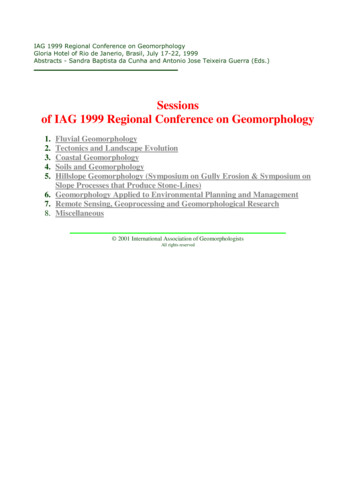
Transcription
When the Rivers Run Dry:Liquidity and the Use of Wholesale Funds in the Transmission ofthe U.S. Subprime Crisis*Claudio RaddatzCentral Bank of ChileFirst Draft: September, 2009This Draft: December, 2010AbstractThis paper provides new systematic evidence of the role of banks’ reliance on wholesalefunding in the international transmission of the financial crisis of 2007-2008. It conductsan event study to estimate the impact of the liquidity crunch of September 15, 2008, onthe stock price returns of 772 individual banks across 44 countries, and tests whetherdifferences in abnormal returns relate to these banks’ ex-ante reliance on wholesalefunding. Globally and within countries, banks that relied more heavily in non-depositsources of funds experienced a significantly larger decline in stock returns even aftercontrolling for other transmission mechanisms.JEL Codes: G01, F36, G21.Keywords: Financial crisis, contagion, wholesale funds market, event study* E-mail: craddatz@bcentral.cl. Most of this version was written when I was with the World Bank DECRG.I thank Alfonso Astudillo for superb research assistance and the World Bank Grant for Research onthe Financial Crisis for financial support. Comments from Ari Aisen, Luis Serven, Matias Braun, MarcelFratszcher, and seminar participants at the Center for Applied Economics of the University of Chile, theCentral Bank of Chile, the World Bank, University of Chile, University Adolfo Ibañez, and the AnnualMeetings of the Latin American Economic Association are gratefully acknowledged. All views expressedin this paper are the author’s only and do not necessarily represent those of the Central Bank of Chile.1
1 IntroductionDuring the second half of 2007, the problems caused by the increase in defaults in US subprimemortgages--observed since late 2006, quickly started to spread across asset classes and countries.This spread resulted in an international financial crisis with strong repercussions in the real USand global economy even as of late 2010.The crisis has reshaped the global financial landscape: Bear Stearns and Lehman Brothers, twoof the largest US investment banks, merged or filed for bankruptcy. The US government bailedout the two largest US banks, Citibank and Bank of America, and the insurance giant AIG, andput under conservatorship Fannie Mae and Freddy Mac, the two largest US mortgagecompanies. As a result, the traditional model of investment banking that dominated Wall Streetduring the 20th century disappeared altogether. Outside the US, many large financial institutionshave either experienced large losses or been taken over by their governments, such as BNPParibas in France, Northern Rock in the UK, UBS in Switzerland, and IKB in Germany, just toname a few. In other countries, like Iceland and Ireland, the whole banking system has been atthe verge of collapse and has received massive government bailouts and guarantees, some ofwhich have lead to serious fiscal problems1The magnitude and reach of the ongoing financial crisis, several orders of magnitude larger thanthe size of the initial shock, has led many to wonder how a shock to a seemingly small segmentof the US financial market managed to propagate so much, so fast. By July 2007 most analystsstill expected limited consequences from the collapse of the subprime mortgage market becauseit represented only about 12 percent of the overall US mortgage market, which in turn was only30 percent of US fixed income markets (Deutsche Bank, 2007). As frequently mentioned, USstock markets routinely dealt with the expected losses in subprime loans, then valued at about 200 billion. A widespread contagion across asset classes and especially across countries wasconsidered unlikely. For instance, on May 17, 2007, the chairman of the US Federal Reserve,Ben Bernanke, stated: “We believe the effect of the troubles in the subprime sector on thebroader housing market will be limited and we do not expect significant spillovers from thesubprime market to the rest of the economy or to the financial system.”1On September 30th, 2008, Ireland’s finance minister announced a blanket guarantee on the deposits andalmost all the debt of the country’s six biggest banks until September 2010. The Iceland governmentnationalized its three largest banks on early October 2008. These policies imposed large fiscal burdensthat have leaded the Irish government to seek help from the International Monetary Fund.2
Although a standard real channel through trade linkages with the US has undoubtedly played arole in the international transmission of the crisis (Levchenko et al. 2009), the timing of some ofthe events strongly suggests that the first line of action took place through internationalfinancial linkages. For instance, the bank run on Northern Rock took place in September 2007,only one month after the beginning of the crisis in the US and when the US economy had notstarted to contract yet.This paper studies the financial mechanisms behind the international transmission of the crisis.In particular, the role of the increasing use of wholesale funds as a source of financing for banksand other financial institutions. Among several possible sources of financial linkages such asexposure to correlated risks, a global decline in risk appetite, and shocks to investors orinstitutions with positions in many markets, there has been during this crisis a lot of attentionfocused on the potential role played by the worldwide reliance of financial institutions on shortterm wholesale funds. There are three basic reasons for this attention. First, the crisis resultedin a sharp and widespread collapse in US wholesale and interbank market funds, including repomarkets (Brunnermeier, 2009; Gorton, 2009). Second, interbank markets have becomeincreasingly connected, so the contraction in interbank lending was not limited to the US, butconsisted in a worldwide decline in liquidity provision (Acharya and Merrouche, 2009; Brunettiet al. 2009). Finally, financial institutions worldwide have increasingly relied on wholesalefunding to supplement demand deposits as a source of funds, becoming, therefore, vulnerable toa sudden dry up of them.2The combination of these three ingredients could explain the global spread of distress across thefinancial sectors of different countries, particularly across their banking sectors. In fact, althoughthe earlier literature emphasized the benefits of these alternative sources of financing (Feldmanand Schmidt, 2001; Calomiris, 1999), some voices of concern about the implications of thisliability structure for systemic vulnerability had been raised before the crisis. For instance,Rajan (2006) noted that banks’ greater reliance on market liquidity makes their balance sheetsmore suspect in times of crisis, and Demirguc-Kunt and Huizinga (2009) found that a bank’sreliance on non-deposit sources of funds increases its risk. These concerns increased as theongoing financial crisis started to unfold, and recently various papers and publications havesuggested that banks’ reliance on wholesale funds may have been behind the failure of someinstitutions. Shin (2009) indicates that the cause of the Northern Rock demise was not itsreliance on securitization, but rather its high leverage, coupled with its reliance on institutionalinvestors for short-term funding. The Economist (2008), citing Citigroup analysts stated that:2Stylized facts backing these claims will be presented in section 2.3
“A growing number of banks are being subjected to a wholesale version of a bank run, withaccess to wholesale funding evaporating in a matter of days, if not hours”. Also in its recentreview of the causes of the recent financial crisis, Brunnermeier (2009) indicates that banks’increasing use of short-term maturity instruments left them particularly exposed to a dry-up infunding liquidity, and Huang and Ratnovski (2008) present a theoretical model that highlightsthe dark side of bank wholesale fundingHowever, despite the emphasis recently put on the use of wholesale funding as a source ofinternational propagation of the crisis, and the anecdotal evidence from cases like the one ofNorthern Rock, there is so far no systematic evidence of its role and its potential to facilitatebroad international contagion independently of other real and financial transmissionmechanisms. Was the increasing use of wholesale funds by banks worldwide systematicallyimportant for the international transmission of the crisis, or was the failure of some wholesaledependent banks an anecdotal side show?This paper aims to answering this question and provides systematic evidence of the importanceof banks’ reliance on wholesale funding as a source of vulnerability, and of its contribution tothe international transmission of the financial crisis. The paper focuses on the largest episode ofthe crisis: the bankruptcy of Lehman Brothers on September 15, 2008 (henceforth “Lehman”).This event resulted not only in a sharp liquidity crunch but also in an abrupt decline in assetprices and risk appetite, constituting an ideal shock to study the qualitative and quantitativeimpact of various channels of financial contagion. The methodological approach combines in anovel way ingredients from a standard event study with those of difference-in-differenceestimation to determine the impact of Lehman on the stock-price returns of 772 individualbanks across 44 countries excluding the US, and to test whether differences in abnormal returnsare related to the banks’ ex-ante reliance on wholesale funding, after controlling for other bankcharacteristics. The test relies on the idea that if the use of wholesale funds was important forthe international contagion of the Lehman event, banks with higher dependence on wholesalefunds would be more affected and perform worse than other banks located in the same country.On the other hand, if the main transmission mechanism is unrelated to the banks’ exposure to aliquidity shock, there is no particular reason for wholesale dependent banks to perform relativelyworst after controlling for other bank characteristics related to alternative sources of contagion.Furthermore, if the transmission was purely panic driven, one would observe a large averagedecline in banks performance, unrelated to fundamental bank characteristics.The use of an event study methodology has two important advantages for understanding thechannels of transmission of the crisis. First, as long as the event is unanticipated and exogenous,4
the estimates have a clear causal interpretation: they measure the abnormal impact of the shockon each of the banks in the sample. Therefore, differences in these abnormal impacts acrossbanks provide strong causal indirect evidence on the mechanisms of propagation of the shock.Second, the use of daily data permits isolating the impact of the shock from that of the policyresponses to it. The recent financial crisis was an extremely eventful period where shocks werequickly followed by massive government interventions on many fronts. Looking at long-termperformance differences across banks may confuse their differential responses to the shocksdriving the crisis and to the policy responses taken to alleviate them. It is also more prone toendogeneity problems since a country’s policy responses may be related to the exposure of itsbanks to various sources of risks.The results confirm that the banking sector across the world experienced a large and significantabnormal return decline following this event. Banks’ abnormal returns worldwide declined about3 percent in the three days after Lehman. More interestingly, the results show that, withincountries, banks that before the crisis relied more heavily on wholesale funding experienced alarger abnormal return decline in response to US events than other banks. In the days followingLehman, within a country, the returns of banks with high wholesale dependence (75th percentile)declined about 2 percent more than those with low wholesale dependence (25th percentile). Thisdifference is not only large but also statistically significant. These qualitative and quantitativeresults persist after controlling for other bank characteristics that could explain their differentialresponse to the Lehman episode, such as banks’ riskiness, size, profitability, direct exposure toLehman Brothers, ownership, or specialization. While not the main focus of the paper, theresults show that some of these characteristics also affected the relative returns of banks inmanners that are consistent with increases in counterparty risk and the importance of the toobig-to fail argument immediately after Lehman.Quantitatively, the results show that the use of wholesale funds can explain an importantfraction of the fast global transmission of this event, confirming that the widespread use of thesetypes of funds played a significant role in the propagation of the financial crisis. A similar butweaker pattern emerges during the early stages of the crisis (August 9, 2007) which confirms thepresence of liquidity based transmission but suggests that other factors, such as the exposure ofinternational banks to subprime mortgages, may have initially played a more important role.The main findings of the paper on the differential impact of the event on banks with higherwholesale dependence rely only on the within country, across-banks, daily variation of the data,so they are not driven by country-level differences on the incidence of the crisis, or on anymeasure of aggregate exposure. In addition, the paper’s main results are robust to a battery of5
changes in the details of the specification and estimation procedure. As an extension, the paperexplores the role of some country level characteristics on explaining the vulnerability ofwholesale dependent banks after Lehman, but finds no supportive evidence that many of thecharacteristics mentioned in the policy discussion, such as the coverage of deposit insurance,reduce the vulnerability of wholesale dependent banks to liquidity crunches.The paper also sheds some light on the role of banks’ use of wholesale funds on the transmissionof the crisis to the real economy. Comparing, for each bank in the sample, the last balance sheetreported before and the first balance sheet reported after the bankruptcy of Lehman Brothers, itshows that loans, assets, and loan to asset ratios contracted relatively more in wholesaledependent banks, controlling for other bank’s balance sheet characteristics. The magnitude ofthe relative decline is large, loans grew 0.7 percent slower (on a monthly basis) in a bank at the75th percentile of wholesale dependence than in a bank at the 25th percentile. Because of dataavailability, these results do not come from a high frequency event study and compare outcomesover a long period (typically one year), so the shock is not well identified and may confuse theshocks with the policy responses. Nonetheless, they provide reduced form evidence that thissource of vulnerability may have consequences for the real economy.This paper relates to several strands of literature. First, and most directly, it relates to therecent theoretical and empirical literature on the amplification and propagation of the financialcrisis. This literature has proposed several mechanisms that may have contributed to spread andamplify the initial shocks, such as the presence of Knightian uncertainty among investors(Caballero and Krishnamurthy, 2008), the combination of leverage and margin cycles affectingmarket makers (Brunnermeier, 2009), the use of wholesale funds (Shin, 2009), the impact ofuncertainty on the behavior of the repo market (Gorton and Metrick, 2009), and the use of procyclical leverage (Adrian and Shin, 2008). In addition, some recent empirical papers havestudied the role of common factors on the movement of banks’ debt spreads during the crisisand their relation to various transmission mechanisms (Eichengreen et al., 2009), and testedwhetherthe crisis spills over to the real economy through reducing consumer demand ortightening liquidity (Tong and Wei, 2008).This paper contributes to this literature byproviding systematic evidence of the role of the sources of bank financing in the internationaltransmission of the crisis. In contrast to Eichengreen et al. (2009), this paper looks at a broadset of banks across a large number of developed and developing countries, and for the most partfocuses on differences in returns across individual banks to identify specific transmissionmechanisms rather than focusing on common factors and their determinants. This paper shareswith Tong and Wei (2008) the use of stock market returns and ex-ante characteristics to6
identify transmission mechanisms. However, it looks at the international transmission of thecrisis to the banking sector instead of the transmission to non-financial US industries, andfocuses on the stock market responses to a clearly defined episode to identify the mechanism,instead of looking at the long-run performance of stock price returns.Another recent literature closely related to this paper has focused on the role of interbankmarkets in the allocation of liquidity during the crisis, and on the appropriate policyinterventions in these markets (Allen Carletti and Gale, 2008; Freixas, Martin, and Skeie, 2009).This literature has also analyzed theimpact of central bank intervention on Europeaninterbank markets during the crisis (Brunetti, di Filippo, and Harris, 2009) and the relationbetween European banks’ demand for liquidity during the crisis and their posterior performance(Cassola, Hortacsu, and Kastl. 2009). This paper complements this literature by providingfurther evidence of the consequences of a drying up of interbank lending markets on banks’performance and lending activities worldwide, thus highlighting the possibility of internationalcontagion and giving further ground for liquidity support by central banks.The paper also relates to the literature on financial structure and riskiness that discusses theimpact of the recent changes in the composition of banks’ assets and liabilities on their ability togather spare liquidity in episodes of crisis (Rajan, 2006; Gatev and Strahan, 2006). This paperprovides evidence that the increased reliance of banks on wholesale sources of funds, whilereducing their dependence on retail deposits, increases their vulnerability to shocks to the moneymarket, and indeed reduces their ability to intermediate the remaining liquid funds towardlending activities.This paper also contributes to the literature on international contagion (Glick and Rose, 1999;Kaminsky and Reinhart, 2000; Kaminsky et al., 2003; among others), by providing evidence of adifferent channel through which financial turmoil may spread across countries. In addition tothe common portfolio positions highlighted by the models following the Asian and Russian crises(Calvo, 1998; Calvo and Mendoza, 2000; Kaminsky and Reinhart, 2000; Kaminsky andSchmukler; 1999), the evidence in this paper shows that the development of international moneymarkets may help spread financial malaise by globally spreading the impact of money marketshocks. The contagion does not only come from a country-specific shock that propagates tocountries financially linked to the affected one, but also from a common shock that affects thosecountries that are structurally exposed to it. Furthermore, the evidence in this paper is robustto the standard criticism that it is difficult to separate trade links and financial links at theaggregate level to determine the channels of contagion. This is because the identification comes7
mainly from within country differences in returns across banks, so it controls for country leveldifferences in exposure through trade linkages.Finally, this paper is closely related and complementary to a recent parallel paper by Beltrattiand Stulz (2009) that characterizes what banks suffered more during the recent crisis and findsthat banks with more deposits did relatively better. While sharing some findings, the two papersdiffer in several dimensions, most importantly in terms of the sample and the methodologicalapproach. Regarding the sample, Beltratti and Stulz (2009) focuses mainly on large commercialbanks, while this paper does not impose restrictions on the size or asset composition of banks.Although their approach maintains a more homogeneous sample across countries, the broadersample used in this paper includes more countries and more variation in the bank characteristicsunder study, which is important for the focus of this paper on the channels of internationaltransmission. In terms of methodology, Beltratti and Stulz (2009) study the performance ofgross returns during a 6-quarter period or longer, while this paper conducts an event study tocharacterize the evolution of abnormal returns in a narrow window around the failure ofLehman Brothers. Although, by design, the event-study approach does not allow one to drawconclusions about the relative performance of banks over a long period, it has importantadvantages in terms of attributing causality and separating the impact of the shock from theresponses to it, as discussed above. Finally, this paper also explores the consequences of theshock on the real side of the economy. Nonetheless, the persistence of some key results despitethese differences strengthens the conclusions of both papers.The rest of the paper is structured as follows. Section 2 describes the recent evolution of thewholesale funds market, the main events of the financial crisis, and the evolution of the cost ofliquidity during these episodes. Section 3 describes the empirical methodology and data sources.Sections 4 and 5 present the main results and robustness analysis, respectively. Section 6explores country characteristics and vulnerability to a liquidity crunch. Section 7 looks at thereal consequences of the use of wholesale funds on banks’ lending activity. Finally, section 8concludes with some final remarks.2 Wholesale Funding Market, the Financial Crisis, and the Cost of LiquidityBanks have traditionally financed their operations with demand deposits, suggesting that theincentives that the threat of a run imposes on bank managers make them a superior form offinancing despite their fragility (Diamond and Rajan, 2001). However, banks also rely on othertypes of markets for their funding needs: commercial paper, repo market, and federal funds8
(interbank) loans. These markets, which typically offer short-term financing, compose thewholesale funding markets.The reliance of various types of intermediaries, particularly commercial banks, on these sourcesof funding has increased importantly in recent years in the US and around the world (Feldmanand Schmidt, 2001; Huang and Ratnovski, 2008; Demirguc-Kunt and Huizinga, 2009). Forinstance, the gross amount of deposits from foreign banks has increased from 6,240 to 13,856billion US dollars between 2001 and 2006 among the 41 countries surveyed by the Bank ofInternational Settlements (BIS, 2008). This increased reliance on wholesale funds can also beseen in bank-level data from Bankscope that show an increase in the use of wholesale sources offunds in the 5 years preceding the beginning of the 2007-2008 financial crisis. Across all bankslocated in the 44 countries covered by Bankscope that have an FTSE financial sector index(which will constitute this paper’s sample, as explained below), the average fraction of liabilitiesthat do not correspond to deposits increased in around 60 percent between the end of 2001 and2006. The increases are larger among commercial banks, reaching about 80 percent. Beyondthese global tendencies, the average fraction of non-deposit liabilities increased in 73 percent ofthe 44 countries described above, with an average increase of 38 percent between 2001 and 2006.Despite the potential advantages of a broad base of funding, and the apparent fragility ofdemand deposits, it has been recently recognized that wholesale funds are more volatile thandemand deposits—probably because they are typically uninsured, and put banks at risk ofliquidity dry-ups (Rajan, 2006), such as those occurring during the ongoing financial crisis. Thishas led some authors to suggest that the reliance of some banks on these sources of funds canexplain the demise of some financial institutions and part of the crisis depth (Shin, 2008).Although there is broad consensus that the earliest indicator of the crisis was the increase indefaults on loans related to securitized subprime mortgages observed in early 2007(Brunnermeier, 2009), its unraveling started only by mid 2007 and, despite the fluidity of thesituation and at the risk of oversimplifying, took place in two stages. The first stage started onAugust 9, 2007, when as a result of the uncertainty about the exposure of financial institutionsto “toxic assets”, liquidity quickly dried up. During this episode, the market for Asset BackedCommercial Paper (ABCP), the standard way in which mortgage securitizers financed theiroperations, practically disappeared, and the price of liquidity, measured as the TED spread,more than doubled in two days, from 44 bps on August 8 to 103 bps on August 10, 2007. Stockprices declined in the US and several other countries, expected volatility increased and riskappetite started to decline. These developments are apparent in Figure 1, which shows theevolution of various financial market indicators for the US and the rest of the world.9
The second, and most important, stage started on September 15, 2008, immediately after the USgovernment decided not to bail out the investment bank Lehman Brothers, and all the majorrating agencies downgraded the long-term debt of giant insurance company AIG.3 The resultwas a much more pronounced but similar pattern than that observed in early August 2007.Global stock markets plummeted, expected volatility skyrocketed, and the cost of liquidity inthe US and abroad, measured by the TED spread or the LIBOR-OIS spreads, raised tohistorically unseen levels that thwarted the increase observed a year before, as seen in thevarious panels of Figure 1. The combination of fast and large shocks to several key financialmarket indicators makes the failure of Lehman Brothers an ideal event to study the differentmechanisms of transmission of the financial crisis across asset classes and countries.In addition to having a large de-facto impact on financial markets, the bankruptcy of LehmanBrothers was largely unexpected. A simple indicator of this is the large and sudden amount ofattention it captured from the international press, as seen in Figure 2, which shows the dailyevolution of the number of news stories published in the global English media containing theterm “crisis” and either “financial”, “finance”, or “subprime” around the bankruptcy of LehmanBrothers (Panel A). There was a clear increase in the number of news stories related to thecrisis immediately after this event (the day after). A similar, albeit smaller pattern is seen afterthe beginning of the liquidity crunch on August 9, 2007, mentioned above (Panel B).Clearly, despite the overall volatility in international liquidity markets, the September 15, 2008episode stands out because of its magnitude and fast onset. Based on these characteristics, thispaper treats this episode as an “event”, and applies a standard event-study approach to test itsinternational transmission. In what follows, I will refer to the Lehman Brothers bankruptcyepisode as the Lehman event (September 15, 2008). Although not the main focus of the paper, Iwill also look at the days following August 9, 2007 as an additional event of liquidity crunch toverify that a similar pattern is seen in the data.3 Methodology and DataThe impact of the failure of Lehman Brothers on the stock-price returns of banks with differentlevels of use of wholesale funds is estimated using a regression version of a standard event studythat allows the abnormal returns to differ across banks according to their ex-ante use of thesefunds and other characteristics. To this end, the first step is to estimate the parameters of thefollowing specification during a period of T1 “normal” days preceding the event,3The problems were so severe that this large insurance company had to be rescued by the US governmenton September 16, 2008.10
Ri,c,twhere t0t1i,ci,c ·Rc,tti,c,t(1)t0 , t1 ,t * denote the beginning and end of the time window where parameters areestimated (the estimation window), and Ri,c,t is the stock-market return of bank i, from countryc, between trading days t - 1 and t. In the preferred specification, Rc,t is a vector that containsthe overall stock-market and banking industry return in country c at time t (a simple two-factormodel), but I also estimate a one-factor model that only controls for the stock-market return tocharacterize the evolution of the whole banking industry. The parametersspecific coefficients to be estimated, andi,c,ti,candi ,care bankis a random error.4The abnormal returns of bank i from country c, ˆi,c,t are computed as the deviation of the actualreturns from those predicted by the model in equation (1) in a window of 2T 1 days aroundthe event (the event window),ˆi,c,tˆi,cRi,c,tˆi,ct*Rc,t , tT, t *(2)T .If banks’ use of wholesale funds plays no role in the propagation of the events, the averageabnormal returns of banks with high and low use of wholesale funds should not be significantlydifferent following the events. This hypothesis can be formally tested by estimating theparameters of the following regression:t* Tˆi, c, twhere D0,c,,t(t* T0, , cW1, i, c)·DXi, c 2,,tvc ,i, tis an event-time dummy that takes the value 1 when t(3)and zero otherwise, andamong all banks from country c includedis the average abnormal return at event timein the regression. Notice that this controls for any
Ben Bernanke, stated: "We believe the e. ffect of the troubles in the subprime sector on the broader housing market will be limited and we do not expect significant spillovers from the . subprime market to the rest of the economy or to the financial system." 1. On September 30. th











